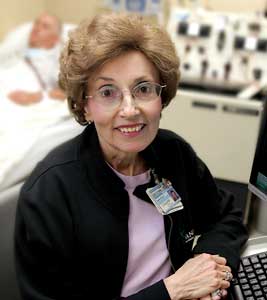A Closer Look
Carol Kelso, R.N., apheresis nurse
June 29, 2012 | Jessica Pasley
In a two-room office space, tucked away on the second floor of the Vanderbilt Clinic, Carol Kelso, R.N., administers a therapy that doesn’t come with a prescription.
“The most important thing I do is give (patients) hope,” she said.
As an apheresis nurse, Kelso collects blood stem cells from both patients and healthy donors for use in future stem cell transplant procedures to treat blood cancers, neuroblastoma, and other life-threatening illnesses. These conditions require a stem cell or bone marrow transplant for a chance of survival.
“I don’t really think about what I do as being a major role in this process, but I do know that I do have an impact.

Carol Kelso, R.N.
“I am giving people hope for a second chance. And that can go a long way.”
For the past 18 years, Kelso has performed the same task with little deviation. She ushers her client into a private room. Upon entering, the patient receives a growth factor injection to promote the growth and release of their stem cells. Kelso completes a final health history and vital signs necessary to move forward with the potentially life-saving procedure. With a comforting smile, gentle hand and kind spirit, Kelso connects the patient to the apheresis machine.
From one arm or catheter, the blood is removed and passed through the machine, which separates the blood into its components (red cells, white cells, platelets and plasma). The stem cells (contained in the white cell component) are collected, and the remaining blood components are returned to the patient through the other arm or a second catheter line.
Peripheral blood stem cell collection is a non-surgical procedure that takes up to four hours. Some patients return for multiple days until the desired amount of cells has been gathered.
The basics of Kelso’s job have remained the same – down to the type of blood separator used – but a few things have changed including the number of collections performed. Kelso recalls going weeks without having a patient for a collection when she first started. But now she and her colleague can collect as many as five patients in one day, using both patient rooms. She also said the age span of the patients is widening.
“Our youngest patients were 7 months old,” she said. “And with people living longer, the chances of developing some kind of cancer increases. So we are seeing older patients too.”
Kelso maintains that her job, although routine, is neither boring nor typical. She points to her “phenomenal” work group and the reality of the importance of her daily tasks.
“I love my job,” she said.
“With stem cell collection, we are giving people hope – hope that either they will get better themselves or that an allogeneic donor will be able to help someone else.
“And one of the best parts of my job… the hugs. It’s funny really. Our patients are forever hugging us, giving us all the credit and they are the ones who did all the work and made the major impact!
“When you love what you do, it’s rewarding.”
Kelso received her nursing diploma from Mercy Hospital in Pittsburgh. Upon graduating she worked at the hospital for five years. She joined the Red Cross, where she was introduced to apheresis collection. After 27 years, she left the Red Cross to help set up the stem cell collection service at Vanderbilt in 2003. (Stem cell transplants were started at Vanderbilt in 1990 with the Red Cross doing the collections).
“I’ve had my hands in stem cell collection at Vandy from the beginning,” said Kelso. “I feel like I have ownership in the
program, that it is part of me. My plan? To be the oldest nurse working here!”
